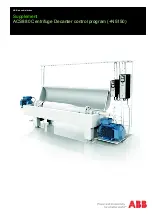
Bus Transaction Modes
1395
SLAU723A – October 2017 – Revised October 2018
Copyright © 2017–2018, Texas Instruments Incorporated
LCD Controller
has completed transferring the contents of a bounded frame buffer 1.
•
DMA end-of-frame 0: The DMA end-of-frame 0 (EOF0) interrupt is triggered when the DMA module
has completed transferring the contents of a bounded frame buffer 0.
•
DMA palette loaded: When PALMODE is set to Palette-only or data, the palette loaded
interrupt is triggered when the palette portion of the DMA transfer has been stored in the Palette RAM.
•
DMA FIFO Underflow: The FIFO Underflow (FIFOU) interrupt is triggered when the real-time output
needs to send a value for pixel data but one cannot be found in the FIFO.
•
AC Bias Count Decremented to Zero: For Passive Matrix displays, a count can be kept of the number
of times the AC Bias line toggles. Once the specified number of transitions has been seen, the AC
Bias Count (ACBS) interrupt is triggered. The module does not post any further interrupts or keep
counting AC Bias transitions until the interrupt has been cleared.
•
Frame synchronization lost: When the DMA module reads a frame buffer and stores it in the FIFO, it
sets a start frame and an end frame indicator embedded with the data. On retrieving the data from the
FIFO, the Sync Lost (SYNCS) interrupt is triggered if the start indicator is not found at the first pixel of
a new frame.
•
Recurrent Raster mode frame done: In raster mode, the Recurrent Frame Done (RRASTRDONE)
interrupt is triggered each time a complete frame has been sent to the interface pins.
•
Raster or LIDD frame done (shared interrupt): In LIDD DMA mode, a frame buffer of data is sent.
When the frame buffer has completed, the LIDD Frame Done (DONE) interrupt is triggered. In order to
do another LIDD DMA, the DMA engine must be disabled and then re-enabled.
In Raster mode, the interrupt is triggered after LCDEN bit is programmed to 0 in the LCD Raster
Control (LCDRASTRCTL) register and after the last frame is sent to the pins. After the Raster mode
DMA is running, the interrupt occurs only once after the module is disabled.
The interrupts are enabled in the LCD Interrupt Mask register (LCDIM) register. All pending interrupts in
the LCD module must be serviced by the Host's Interrupt Service Routine before it exits.
20.5 Bus Transaction Modes
The LCD Controller supports character-based LCD panels by ensuring the bus cycles for reading/writing
commands and data are met. The LIDD (LCD Interface Display Driver) provides this support. The LIDD
interfaces with an Arm CPU in the SoC using a VBUS slave port. Abundant programmable timing
parameters can be configured such that the off-chip interface can support a wide variety of character
based LCD panels. Alternatively, the DMA module can be used to mimic the CPU and perform a
sequence of write-only data bus transactions to the character based LCD panel. The Motorola and Intel
interfaces support asynchronous and synchronous modes. The only difference between the two is that, for
synchronous mode, the internal bus clock is output on a pin that replaces CS1. In other words, only one
character panel can be supported under synchronous mode while two panels can be supported for
asynchronous mode.
20.6 Initialization and Configuration
Basic configuration of the LCD controller is as follows:
1. Enable the LCD Controller in the System Control module using the RCGCLCD register. See
.
2. Enable the DMA, core and LIDD controller (if required) in the LCDCLKEN register.
3. Select the LCD mode (LIDD or Raster) by programming the LCDMODE bit in the LCDCTL register. In
addition, configure the LCDCP or LCDMCLK frequency through the CLKDIV field.
When operating in LIDD mode:
1. Program the LCDLIDDCTL register along with the chip select configuration register, LIDDCSnCFG.
2. Select the DMA parameters in the LCDDMACTL register. Program the frame buffer boundaries in
the LCDDMABAFB0 and LCDDMACAFB0 registers.
3. Enable any required interrupts in the LCDIM register.
4. Initiate LIDD mode transactions by setting the DMAEN bit in the LCDLIDDCTL register.
4. When operating in Raster mode:
















































